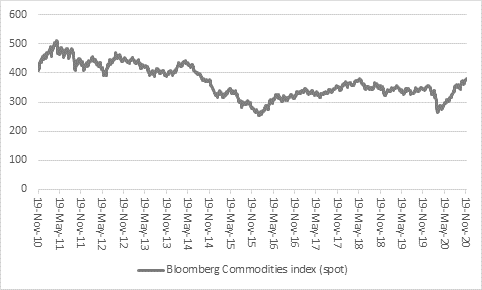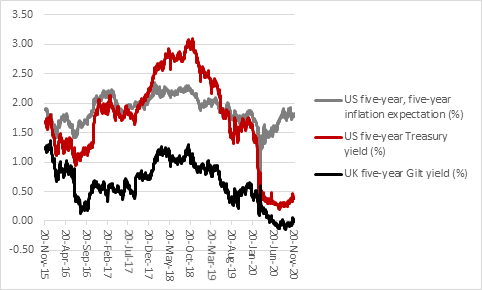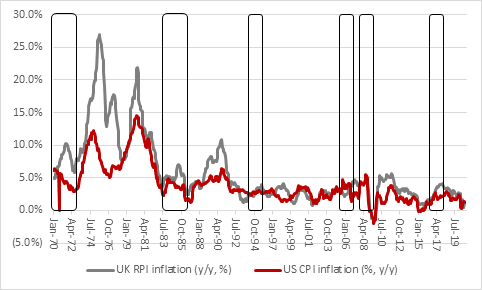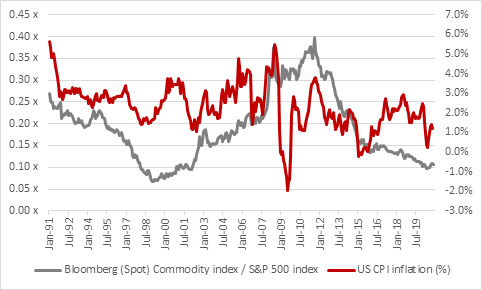“One of the fiercest debates of 2020, at least when it comes to the narrow confines of investment strategy rather than the wider issue of public health, remains whether inflation, stagflation or deflation will be one result of the pandemic and, arguably, some of the policies deployed in response to it,” says Russ Mould, AJ Bell Investment Director. “The bond market still seems convinced that inflation and growth are going to remain subdued for some time to come, but commodities appear to be telling a different story. The Bloomberg Commodities index stands at a two-year high and if raw material prices really start to motor they could start to fuel expectations of higher inflation all on their own.

Source: Refinitiv data
“No-one, but no-one, knows whether inflation, deflation or staglation is coming next – not even central bankers, who, if they did, would not be still using and tweaking policies that were called unorthodox and exceptional when they were launched over a decade ago in further efforts to generate the inflation they seemingly crave.
“Judging by yields of 0.39% on the US five-year Treasury bond and exactly zero on the UK five-year Gilt yield, bond markets remain of the view that deflation remains the danger, or at least that suggests that the new few years are going to be similar to the last ten or so – namely low growth, low inflation and low interest rates.
“Such an environment has a proved fertile breeding ground for long-duration assets such as technology, biotechnology and ‘growth’ stocks, as well as bonds, but harder work shorter-duration assets such as cyclical, or ‘value’ equities and commodities.

Source: Refinitiv data
“Yet not everyone is convinced. Five-year forward inflation expectations have ticked up this year to reach 1.83%, although they are yet to truly break out. Even if 1.83% turns out to the right figure in five years’ time, then developed-market Government bonds offer relatively little protection even from that. Inflation expectations are not rising, at least for the moment, but it will be interesting to see if they are influenced by commodity prices, which are ticking higher once more.
• Copper trades above $7,000 a ton and after a 60%-plus rally since spring trades at its highest mark for two-and-a-half years
• Iron ore is pushing toward $130 a ton and its best mark for at least five years
• Soybeans stand at a four-and-half-year high and corn prices are at the highest level since July 2019
• Cocoa stands at a nine-month high
“The question now is whether this is a trend or not and whether rising raw materials costs for companies and rising food costs for consumers will lead to inflation, should the former jack up their prices to protect profit margins and the latter demand pay rises to help them meet the higher cost of living. In such an uncertain economic environment as the current one, few firms or consumers may be willing to chance their arm, it must be said. But in a post-vaccine world the picture could look very different, emboldening both.
“It is tempting to argue that the increase in copper and iron ore prices is one indication that an economic upturn is on the way, thanks to fiscal and monetary stimulus programmes the world over and expectations that a vaccine is on the way and 2021 will be a better place all round.
“The food price increases may not be quite so conclusive and could just as easily be the result of the La Niña weather pattern which is in evidence this year. This complex meteorological feature occurs relatively rarely – America’s National Oceanic and Atmospheric Administration says this is just the seventh incidence since 1970 – but it can lead to below-average rainfall in Peru and Chile, East Africa and southwestern America but storms and floods to Brazil, Southern Africa, Australia and Asia.
“Investors have enough imponderables to face without having to think about the weather and second-guessing such near-term patterns really would be a mug’s game especially since inflation in America accelerated during only two of the last six La Niña patterns, even if it did so five times in the UK.

Source: Refinitiv data. Blocks indicate the incidence of La Niña.
“Nevertheless, it should be informative to see how the Bloomberg Commodity index fares. Having massively outperformed equities in the first decade of this millennium, commodities were huge laggards in the second.
“This can be seen by simply dividing the value of the Bloomberg Commodity index by the value of the S&P 500. If the line is rises, commodities outperform equities and vice-versa.

Source: Refinitiv data
“Contrarians may be tempted to argue that a bottom is forming and raw materials are primed for a resurgence relative to stocks.
“Whether we are on the cusp of one of those once-in-a-decade shifts that has huge ramifications for asset allocation and equity and fund selection remains to be seen, but commodity prices do not, for the moment at least, share the bond market’s conviction that the next five to ten years are going to see the same economic backcloth as the last five to ten.”
